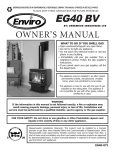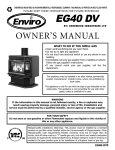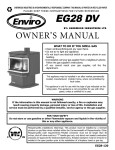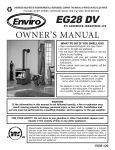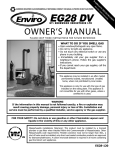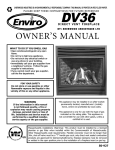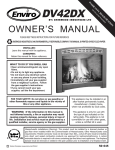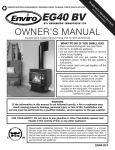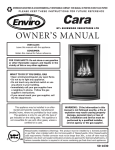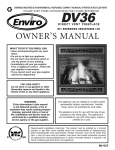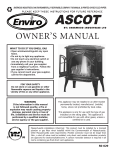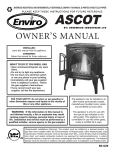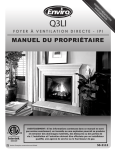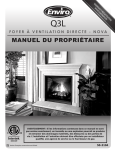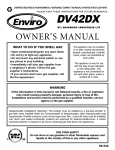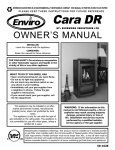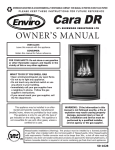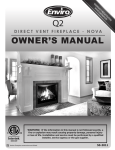Download Sherwood Enviro EG40 DV Owner`s manual
Transcript
SHERWOOD INDUSTRIES IS AN ENVIRONMENTALLY RESPONSIBLE COMPANY. THIS MANUAL IS PRINTED ON RECYCLED PAPER. PLEASE KEEP THESE INSTRUCTIONS FOR FUTURE REFERENCE EG40 DV BY: SHERWOOD INDUSTRIES LTD OWNER’S MANUAL WHAT TO DO IF YOU SMELL GAS • Open windows/Extinguish any open flame. • Do not try to light any appliance. • Do not touch any electrical switch or use any phone in your building. • Immediately call your gas supplier from a neighbour’s phone. Follow the gas supplier’s instructions. • If you cannot reach your gas supplier, call the fire department. This appliance may be installed in an after market permanently located, manufactured (mobile) home, where not prohibited by local codes. This appliance is only for use with the type of gas indicated on the rating plate. This appliance is not convertible for use with other gases, unless a certified kit is used. WARNING If the information in this manual is not followed exactly, a fire or explosion may result causing property damage, personal injury or loss of life. Installation and service must be performed by a qualified installer, service agency or the gas supplier. FOR YOUR SAFETY: Do not store or use gasoline or other Flammable vapours and liquids in the vicinity of this or any other appliance. Massachusetts installations (Warning): This product must be installed by a licensed plumber or gas fitter when installed within the Commonwealth of Massachusetts. Other Massachusetts code requirements: Flexible connector must not be longer than 36in., a shut off valve must be installed; only direct vent sealed combustion products are approved for bedrooms/bathrooms. A carbon monoxide detector is required in all rooms containing gas fired direct vent appliances. EG40-070 Safety Precautions FOR SAFE INSTALLATION AND OPERATION OF YOUR “ENVIRO” HEATER, PLEASE CAREFULLY READ THE FOLLOWING INFORMATION: • All ENVIRO gas-fired appliances must be installed in accordance with their instructions. Carefully read all the instructions in this manual first. Consult the building authority having jurisdiction to determine the need for a permit prior to commencing the installation. • NOTE: Failure to follow these instructions could cause a malfunction of the fireplace, which could result in death, serious bodily injury, and/or property damage. • Failure to follow these instructions may also void your fire insurance and/or warranty. GENERAL • Installation and repair should be done by a qualified service person. The appliance should be inspected before the first use and, at least, annually by a qualified service person. More frequent cleaning may be required due to excessive lint from carpeting, bedding material, etc. It is imperative the control compartments, burners and circulating air passageways of the appliance be kept clean. • Due to high temperatures, the appliance should be located out of high traffic areas and away from furniture and draperies. Children and adults should be alerted to the hazards of high surface temperatures and should stay away to avoid burn or clothing ignition. • Young children should be carefully supervised when in the same room as the appliance. • Clothing or other flammable materials should not be placed on or near the appliance. FOR YOUR SAFETY • Installation and service must be performed by a qualified installer, service agency or gas supplier. • This installation must conform to local codes or, in the absence of local codes, to the current CAN/CGAB149 installation code (Canada) or National Fuel Gas Code ANSI Z223.1.2 (USA) 2 • To prevent injury, do not allow anyone who is unfamiliar with the stove to operate it. • To prevent injury, if the pilot or pilot and burners have gone out on their own, open the glass door and wait 5 minutes to air out before attempting to re-light the stove. • Always keep the area around these appliances clear of combustible material, gasoline and other flammable liquids and vapours. • These appliances should not be used as a drying rack for clothing or for hanging Christmas stockings/ decorations. • Due to the paint curing on the stove, a faint odor and slight smoking will likely be noticed when the stove is first used. Open a window until the smoking stops. Always connect this gas stove to a vent system and vent to the outside of the building envelope. Never vent to another room or inside the building. Make sure the specified vent pipe is used, properly sized and of adequate height to provide sufficient draft. Inspect the venting system annually for blockage and signs of deterioration. WARNING: Failure to position the parts in accordance with the diagrams in this booklet, or failure to use only parts specifically approved with this appliance, may result in property damage or personal injury. WARNING: Do not operate with the glass front removed, cracked or broken. Replacement of the glass should be done by a licensed or qualified service person. • Never use solid fuels such as wood, paper, cardboard, coal, or any flammable liquids, etc., in this appliance. • Do not use this heater if any part has been under water. Immediately call a qualified service technician to inspect the heater and to replace any part of the control or gas control systems that have been under water. • Do not abuse the glass by striking it or slamming the door shut. Table of Contents Safety Precautions...............................................................................2 Table of Contents.................................................................................3 Codes And Approvals...........................................................................4 Specifications......................................................................................5 Dimensions..............................................................................5 Rating Label Location................................................................5 Operating Instructions.........................................................................6 Lighting Instructions.................................................................6 Normal Sounds During Operation...............................................7 Adjusting The Venturies.............................................................7 Maintenance and Service......................................................................8 Opening The Door....................................................................8 Cleaning The Glass...................................................................8 To Replace Door........................................................................8 Cleaning The Firebox................................................................8 Cleaning Plated Surfaces...........................................................9 Burner Removal........................................................................9 Replacing The Blower................................................................9 Fuel Conversion......................................................................10 Initial Installation...............................................................................12 Preparation For Installation......................................................12 Clearances to Combustibles.....................................................12 Planning Your Installation........................................................13 Corner Installations.................................................................14 Mobile Home Installation.........................................................14 Vent Termination Restrictions...................................................15 Freestanding Direct Vent Kit With Coupler.................................16 Other Approved Vent Parts......................................................18 Vent Configurations.................................................................20 Vent Restrictor Ring................................................................20 Horizontal Installation..............................................................21 Vertical Installation..................................................................23 Cathedral Ceiling Installation....................................................25 Venting into a Class ‘A’ Chimney...............................................26 Electrical Requirements...........................................................27 Gas Line Connection and Testing..............................................28 Secondary Installation........................................................................29 Log Set and Embers Installation...............................................29 Trouble Shooting................................................................................31 Parts List...........................................................................................32 Parts Diagram - Chassis......................................................................34 Parts Diagram - Gas Tray & Door.........................................................35 Warranty...........................................................................................36 Installation Data Sheet.......................................................................39 3 Codes And Approvals DIRECT VENT: This type is identified by the suffix DV. This appliance draws all of its air for combustion from outside the dwelling, through a specially designed vent pipe system. This appliance has been tested and approved for installations from 0 ft to 4500 ft (1372 m) above sea level. In the USA: The appliance may be installed at higher altitudes. Please refer to your American Gas Association guidelines which state: the sea level rated input of Gas Designed Appliances installed at elevations above 2000 ft (610 m) is to be reduced 4% for each 1000 ft (305 m) above sea level. Refer also to local authorities or codes which have jurisdiction in your area regarding the de-rate guidelines. In Canada: When the appliance is installed at elevations above 4500 ft (1372 m), the certified high altitude rating shall be reduced at the rate of 4% for each additional 1000 ft (305 m). • This appliance has been tested by INTERTEK (Warnock Hersey) and found to comply with the established VENTED GAS FIREPLACE HEATER standards in CANADA and the USA as follows: VENTED GAS FIREPLACE HEATER (EG40 DV NG/LPG) TESTED TO: ANSI Z21.88a-2003/CSA 2.33a-2003 VENTED GAS FIREPLACE HEATERS CAN/CGA 2.17-M91 GAS FIRED APPLIANCES FOR HIGH ALTITUDES CSA P.4.1-02 TESTING METHOD FOR MEASURING ANNUAL FIREPLACE EFFICIENCY This ENVIRO EG40 DV Fireplace: • Has been certified for use with either natural or propane gases. (See rating label.) • Is not for use with solid fuels. • Is approved for bedroom or bed sitting room. (IN CANADA: must be installed with a listed wall thermostat. IN USA: see current ANSI Z223.1 for installation instructions.) • Must be installed in accordance with local codes. If none exist, use current installation code CAN/CGA B149 in Canada or ANSI Z223.1/NFPA 54 in the USA. • Must be properly connected to an approved venting system and not connected to a chimney flue serving a separate solid-fuel burning appliance. • Manufactured (mobile) home installation must be in accordance with the Manufactured Home Construction and Safety Standard, UL 307B, Title 24 CFR, Part 3280 and/or The Standard for Manufactured Home Installations, ANSI A225.1/NFPA 501A. The unit must be bolted to the floor of the mobile home and must be electrically grounded to the steel chassis. • Are approved for installation on combustible materials (i.e. Wood, carpet or linoleum). • Is not approved for closet or recessed installations. IMPORTANT NOTICE (Regarding first fire up): When the unit is turned on for the first time, it should be turned onto high without the fan on for the first 4 hours. This will cure the paint, logs, gasket material and other products used in the manufacturing process. It is advisable to open a window or door, as the unit will start to smoke and can irritate some people. After the unit has gone through the first burn turn the unit off including the pilot, let the unit get cold then remove the glass door and clean it with a good gas fireplace glass cleaner, available at your local ENVIRO dealer. 4 Specifications DIMENSIONS: 12 1/2" (318 mm) 4 5/8" (117 mm) 21" (533 mm) 29 1/8" (740 mm) 25" (635 mm) Shipping Weight 256 lbs (116 kg) Figure 1: EG40 Exterior Dimensions. RATING LABEL LOCATION: The rating label is found inside the right cabinet side panel. 5 Operating Instructions FOR YOUR SAFETY READ COMPLETELY BEFORE OPERATING. LIGHTING INSTRUCTIONS: CAUTION: Hot while operating. Do not touch, severe burns may result. Keep children, clothing, furniture, gasoline or other flammable vapors away. CAUTION: Do not operate this fireplace with the glass removed, cracked or broken. Replacement of the panel(s) should be done by a licensed or qualified person! This appliance needs fresh air for safe operation and must be installed with provisions for combustion and ventilation air. See installation and operating instructions manual. Keep burner and control compartment clean. WARNING: Improper installation, adjustment, alteration, service or maintenance can cause injury or property damage, or loss of life. Refer to owner's information manual provided with this appliance. For assistance or additional information consult a qualified installer, service agency or the gas supplier. See installation and operating instructions accompanying appliance. Installation and service must be performed by a qualified installer, service agency, or the gas supplier. FOR YOUR SAFETY READ BEFORE OPERATING WARNING: IF YOU DO NOT FOLLOW THESE INSTRUCTIONS EXACTLY, A FIRE OR EXPLOSION MAY RESULT CAUSING PROPERTY DAMAGE, PERSONAL INJURY OR LOSS OF LIFE. C) Use only your hand to push in or turn the gas control knob; A) This appliance is equipped with a pilot, which must be lit by NEVERuse tools. If the knob will not push in or turn by hand, hand by following these instructions exactly. do not try to repair it. Call a qualified service technician. B) BEFORE LIGHTING smell all around the appliance area for Force or attempted repair may result in a fire or explosion. gas and next to the floor because some gas is heavier than air D) Do not use this appliance if any part has been under water. and will settle on the floor. Immediately call a qualified service technician to inspect the WHAT TO DO IF YOU SMELL GAS: appliance and to replace any part of the control system and Do not try to light any appliance. Do not touch any electrical any gas controlwhich has been under water. switch: do not use any phone in your building. Immediately call your gas supplier from a neighbor's phone. Follow the gas suppliers instructions. If you cannot reach your gas supplier, call the fire department. LIGHTING INSTRUCTIONS 1. 2. 3. 4. STOP! Read the safety information above on this label. WARNING: this gas valve has a lockout device, which will not allow thepilot burner to be relit until the thermocouple has Turn off all electrical power to this appliance. Turn off the gas control knob clockwise to the off position. cooled. If the knob doesdoes not pop up when released, stop and immediately call your service technician or gas supplier. Open door. Wait fIve (5) minutes to clear out any gas. Close If the pilot does not stay lit after several tries, turn the gas door. If you smell gas STOP! Follow “B” in the above safety control knob to “OFF” and call your service technician or information. If you do not smell gas go to the next step. gas supplier. 5. Find pilot-located to the right between the front and rear burner. 6. Turn the gas control knob counter clockwise to the Turn the gas control knob counter-clockwise to “ON” position. Flip the burner switch to “ON” THEN TURN “PILOT”. Push the gas control in fully and hold, keep knob THE “HI/LOW” knob to the depressed for about 30 seconds after the pilot is lit. desired setting. Release knob. If pilot goes out, repeat steps 4 7. Turn on the electrical through 5. power to the unit. IN OUT TP TH I L O TP H O FF PI L OT TH ON LO PI T TO TURN OFF GAS TO APPLIANCE 1. Flip burner switch to “OFF” 2. Turn the gas control knob clockwise to the “OFF” position. 3. Turn off all electrical power to the appliance if service is to be performed. Figure 2: Lighting Instructions. 6 Operating Instructions Thermopile Thermocouple Figure 3: Pilot Burning. Figure 4: Gas Valve. ADJUSTING THE VENTURIES: • There is a separate venturies for each burner, see Figure 5. • Remove one screw from the cover plate located below the ash shelf and loosen the other screw (do not remove) swing the cover plate out of the way and tighten screw down to hold it in place. Rear log holder Front log holder Rear burner • With along screwdriver rotate spring clips to open or close the venturies to the desired setting. Ember tray & front burner Door Venturies Screwdriver Gold bar The venturies allows the amount of air coming into Air shutter cover plate the fireplace to be adjusted in order to accommodate Figure 5: Venturi Adjustment. different climates and venting arrangements. Start the pilot and then the burner. Make sure the pilot flame is burning normally and none of the burner ports are plugged. Let the fireplace burn for roughly fifteen9minutes and then examine the flames, compare the flames to Figure 16. The ideal flame will be blue at the base and light orange above. The flames should be of medium height. If the flames look like this, no venturi adjustment is needed. If the flames are fairly short and mostly blue, the fireplace is getting too much air. Therefore, the venturies should be closed slightly until the correct flames are achieved. Flames that are very orange, with tall, dark, stringy tips, are not getting enough air. Open the venturi until the flames clean up. If the venturi is opened, or closed all the way, and the correct flames cannot be attained, turn off the gas and contact the dealer. Warning: Incorrect venturi adjustment may lead to improper combustion, which is a safety hazard. Contact the dealer if there is any concern about the venturi adjustment. NORMAL SOUNDS DURING OPERATION: Table 1: Normal Sounds Component Sound & Reason EG40 Creaking when heating up or cooling down. Burner Light pop or poof when turned off; this is more common with LP units. Temperature Sensor Clinking when it senses to turn the blower on or off. Pilot Flame Quiet whisper while the pilot flame in on. Blower / Fan Air movement that increase and decreases with the speed of the blower. The blower is pushing the heat from the fireplace into the room. Gas Control Valve Dull click when turning on or off, this is the valve opening and closing. 7 Maintenance and Service Annually check to ensure that your Venting system is clear. Periodically check the pilot and burner. Check to see that all the burner ports are clean and clear. Check the pilot head for blockage. Check to ensure the pilot flame is blue with no or very small yellow tips. OPENING THE DOOR: Turn unit off and wait until the appliance has cooled down. 1. Open the right hand hinged side flap, which will expose a door fastener. Using a 1⁄2” wrench, loosen the fastener. 2. Due to the shape of the bay window door. You must also open the left-hand side flap before attempting to open the door. 3. If the door must be removed open the door and lift the door pins out of the hinges (see Figure 6). 4. Ensure the door is properly fastened after cleaning before attempting to re-light the appliance. ���� �� ��� ������ ����� Figure 6: Removing the Door. CLEANING THE GLASS: Allow the glass to cool before cleaning. It will be necessary to clean the ceramic glass periodically. During a cold start up, condensation will sometimes form on the glass. This is a normal condition with all gas fireplaces and stoves. However, this condensation can allow dust and lint to cling to the glass surface. Initial paint curing of the appliance can leave behind a slight film on the glass. This is a temporary problem. Depending upon the amount of use, cleaning should be required no more than two or three times per season. To clean the door, use a mild glass cleaner and a soft cloth or a glass cleaner available from your Enviro dealer. Abrasive cleaners will damage the glass. Important note: When the unit is turned on for the first time, It should be turned onto high without the fan on for the first 4 hours. This will cure the paint, logs, gasket material and the other products used in the manufacturing process. It is advisable to open a window or door, as the unit will start to smoke and can irritate some people. After the unit has gone through the first burn turn the unit off including the pilot, let the unit get cold then remove the glass door and clean it with a good gas fireplace glass cleaner. TO REPLACE DOOR: The glass in this appliance is an integral part of the door assembly. If the glass is damaged or broken a replacement inner door with glass assembly must be purchased. The glass in this appliance is ceramic. Remove the door with glass, a new door assembly must be purchased from an ENVIRO dealer (part # EC-063). Do not use a substitute materials; it will void the warranty. CLEANING THE FIREBOX: 1. Turn off the unit and allow it to cool down completely. 2. Remove the logs carefully from the firebox. Gently remove the embers and place on a piece of paper towel, until ready to replace. 8 Maintenance and Service 3. Vacuum the bottom of the firebox thoroughly. Carefully clean off any dust on the logs and remove any lint from the main burner and pilot burner. 4. After carefully replacing the log and embers in their correct positions (see Secondary Installation Installation of Log Set and Embers), and the door has been resealed, re-light the pilot, following the instructions on the lighting label attached to the unit. CLEANING PLATED SURFACES: It is important to note that fingerprints and other marks can leave a permanent stain on plated finishes. To avoid this, give the face a quick wipe with denatured alcohol on a soft cloth BEFORE lighting the fireplace. Never clean the face when it is not cool. Do not use other cleaners as they may leave a residue, which can become permanently etched into the surface. BURNER REMOVAL: The burner may need to be removed for a few reasons, including cleaning under the burner, converting the unit to a different gas type, or to replace the burner altogether. Proceed only when the unit has completely cooled down. 1. Remove the door as shown in the MAINTENANCE AND SERVICE - OPENING THE DOOR. 2. Remove the two (2) T-20 screws that hold the burner in place; one (1) at each of the rear burner (see Figure 7). 3. Lift the burner assembly (both the front and rear burners) straight up then out. To re-install the burner follow steps 1-3 in reverse. When placing the burner back in the unit ensure that the venturi box under the burner is lined up. Figure 7: Screws holding Burner. REPLACING THE BLOWER: 1. Turn the unit off, allow it to cool down completely, and remove the door as shown in the MAINTENANCE AND SERVICE - OPENING THE DOOR.. 2. Remove the log set and brick liner. 3. Remove the burner tray assembly, see MAINTENANCE SERVICE - BURNER REMOVAL. AND 4. Remove the four (4) 5/16” bolts that hold the blower mounting plate to the back firewall. Use a light lubricating oil on screws before removal. 5. Carefully pull the blower assembly into the firebox (see Figure 7) disconnect the blower leads from the harness and remove blower. Figure 8: Blower (Fan) Removal. 6. To re-install, check mounting plate gasket if damaged replace with new one and reverse steps 1 through 4. Refer to “SECONDARY INSTALLATION - LOG SET AND EMBERS INSTALLATION”. 9 Maintenance And Service FUEL CONVERSION: TO BE INSTALLED BY A QUALIFIED SERVICE AGENCY ONLY Please read and understand these instructions before installing. Warning: This conversion kit shall be installed by a qualified service agency in accordance with the manufacturer’s instructions and all applicable codes and requirements of the authority having jurisdiction. If the information in these instructions is not followed exactly, a fire, explosion or production of carbon monoxide may result causing property damage, personal injury or loss of life. The qualified service agency is responsible for the proper installation of this kit. The installation is not proper or complete until the operation of the converted appliance is checked as specified in the manufacturer’s instructions supplied with the kit. Kit Parts List: 1 - Orifice (NG - Front #48 DMS & Rear #43 DMS or LP - Front #56 DMS & Rear #54 DMS) 1 - Pilot Injector (NG 0.62 mm; LP 0.35 mm) 1 - Installation instruction sheet 1 - Conversion label Carefully inspect all parts supplied with this conversion kit. If any parts have been damaged or are missing, contact your dealer, distributor or courier company to have them replaced before starting this installation. Conversion Kit Installation: 1. Turn control knob on the gas valve to the “OFF” position and shut the gas supply off at the shut-off valve upstream of the unit. CAUTION: The gas supply must be shut off prior to disconnecting the electrical power and before proceeding with the conversion. Allow the valve and unit to cool down to room temperature. 2. Remove the glass as shown in the MAINTENANCE AND SERVICE - OPENING THE DOOR. 3. Carefully remove the log set and ember material if they are installed. 4. Remove the burner as shown in the MAINTENANCE AND SERVICE - BURNER REMOVAL. 5. Convert the burner orifice(s): a) Remove the main burner orifice with a 1⁄2 inch deep socket. b) Put a bead of pipe-thread sealant or approved Teflon tape on the orifice threads before installing into the brass elbow. c) Install the new orifice(s) from the kit into the brass elbow. 6. Convert the pilot injector: a) Pull the pilot hood straight up to access the pilot injector. b) Using a 5/32” or 4 mm Allen key, remove the pilot injector. c) Install the new pilot injector supplied with this conversion kit. Simply screw the new injector inside the pilot hood using the Allen key, d) Reinstall the hood by placing the hood on the assembly, line up the key Figure 9: Removing way, and snap into place. valve cap. 10 Maintenance And Service 7. Convert the SIT gas valve: a) Remove the black protection cap from the HI/LO knob by hand shown in Figure 9. b) Insert a 5/32” or 4 mm Allen wrench into the hexagonal key-way of the screw (see Figure 10), rotate it counter-clockwise until it is free and extract it. c) Check that the screw is clean and if necessary remove dirt. Loosen d) Flip the screw (refer to Figure 11). Tighten e) Using the Allen wrench as shown in Figure 10, rotate the screw clockwise until a torque of 9 inch lbs. WARNING! Do not over tighten the screw. It is recommended that you grip the wrench by the short side. f) Verify that if the conversion is from NG to LPG, the screw must be re-assembled with the red oring visible (refer to Figure 12). If the conversion is from LPG to NG, the red o-ring of the screw must be not visible. Figure 11: Flip valve Figure 10: Removing valve screw. screw. Red o-ring Red o-ring g) Re-attach the black protection is visible is not visible cap that was removed in step a (Figure 9). 8. Reinstall the burner, brick panels, log set, embers, and glass door. Also refer to SECONDARY INSTALLATION - INSTALLING LOG SET AND EMBERS. When LPG Configuration re-installing the burner, ensure that Figure 12: O-ring on valve screw. the burner to pilot hood relationship is similar to what is shown in Figure 6. On some units you will need to pay special attention when installing the burner that the venturi adjustment rod is properly installed into the venturi adjustment piece welded to the burner venturi tube 9. Reconnect the main gas line if it was disconnected and open the shut-off valve at the gas line to the unit. 10. Use a small brush to apply a warm soapy water solution to all gas connections (use a half dish soap and half warm water). If a gas leak is present, bubbling will occur. Gas leaks can be repaired by using an approved pipe thread sealant or approved Teflon tape. NEVER USE AN OPEN FLAME WHEN TESTING FOR LEAKS. 11. Reconnect the electrical power to the unit. 12. Relight the main burner in both the “HI” and “LO” positions to verify proper burner ignition and operation and proper flame appearance. Also refer to SECONDARY INSTALLATION - LOG SET AND EMBERS INSTALLATION for a flame appearance picture. 13. MAKE SURE that the conversion label is installed on or close to the rating label to signify that the unit has been converted to a different fuel type. 11 Initial Installation QUALIFIED INSTALLERS ONLY WARNING: Operation of this heater when not connected to a properly installed and maintained venting system can result in carbon monoxide (CO) poisoning and possible death. PREPARATION FOR INSTALLATION: • Remove the packaging from the appliance, and check to make sure there is no damage. If damage is found, please report it to both the carrier and your dealer as soon as possible. • Before beginning, carefully check the glass door and the log set • Locate a position where the flue system of the stove can be properly installed without damaging the integrity of the building; e.g. cutting a wall or ceiling joist. • Check stove and flue system clearance requirements. • Locate the stove where it can be accessed by a gas supply line. • Locate the stove in a large and open room that is centrally located in the house. This will optimize heat circulation and comfort. • As the stove is equipped with a convection fan, ensure that an electrical outlet is within 6 ft (1.8 m) of the stove. • The flow of combustion and ventilation air must not be obstructed. CLEARANCES TO COMBUSTIBLES: A. Sidewall to unit 12 inches (30.5 cm) B. Backwall to unit 4 inches (10.2 cm) C. Corner to unit 2 inches (5.1 cm) D. Combustibles to unit top 36 inches (91.4 cm) E. Floor to unit 0 inches F. Alcove maximum depth: 48 inches (121.9 cm) �� ���� ��� �� ��� ��� ��� ���� ��� (0 cm) Figure 13: Clearances to combustibles. CLEARANCES MUST BE SUFFICIENT TO ALLOW ACCESS FOR MAINTENANCE AND SERVICE. 12 Initial Installation QUALIFIED INSTALLERS ONLY PLANNING YOUR INSTALLATION: When planning your installation, it will be necessary to select the proper length of vent pipe for your particular requirements. It is important to note when passing through a wall, the maximum allowable wall thickness is 10 inches (25.4 cm), 11⁄2 inches (3.8 cm) clearance to combustibles must be maintained. Select the amount of vertical rise desired for “vertical-to-horizontal” type installations. To determine the length of vent pipe required for vertical installations, measure the distance from the appliance flue outlet to the ceiling, the ceiling thickness, the vertical rise through the attic or second story, and allow for sufficient vent height above the roof line. For two story applications, a fire stop is required at each floor level. If an offset is needed in the attic, additional pipe and elbows will be required. To connect the venting system to the appliance flue outlet, a twist-lock adapter is built into the appliance at the factory. Refer to ‘Vent Configuration and Restrictor Settings’ for venting parameters. Your total vent pipe length must be within the shaded area of Figure 22. If a 90° elbow is used in the horizontal plane, 36” (91.4 cm) must be subtracted from the allowable horizontal run. There are two (2) basic types of Direct Vent System installations; they are shown in Figure 14 and 15. Round Support Box/Wall Thimble Vertical Termination Storm Collar Horizontal Termination Flashing Pipelength Ceiling Firestop 90° Elbow Round Support Box/Wall Thimble Cathedral Ceiling Support Box Pipelength Figure 14: Common Horizontal Installation. Pipelength Pipelength Figure 15: Common Vertical Installation. 13 Initial Installation QUALIFIED INSTALLERS ONLY CORNER INSTALLATIONS: Do not interfere with the structural integrity of the walls. Outside or Inside Wall Outside Wall Figure 16: Corner installation top vented. MOBILE HOME INSTALLATION: • When the unit is installed in a Mobile Home it must be grounded to the steel chassis or connected to a grounding rod. • In a Mobile Home installation the unit must be bolted securely to the floor using the holes provided (see Figure 17). • Manufactured (mobile) home installation must be in accordance with the Manufactured Home Construction and Safety Standard, UL 307B, Title 24 CFR, Part 3280 and/or The Standard for Manufactured Home Installations, ANSI A225.1/ NFPA 501A Holes for screws to hold down the unit. Figure 17: Screw the pedestal down for mobile homes. 14 Initial Installation QUALIFIED INSTALLERS ONLY VENT TERMINATION RESTRICTIONS: N O H D E L B C B B Fixed Closed F Openable B G Fixed Openable Closed A Termination Cap G M J Air Supply Inlet G Gas Meter K I Restriction Zone A (Termination not allowed) Figure 18. Vent Termination Restrictions, refer to Table 2. Table 2: Vent termination clearances, refer to Figure 18. Letter Canadian Installation A B 1 2 US Installation 12 in (30 cm) 12 in (30 cm) Description Clearance above grade, verandah, porch, deck, or balcony. 9 in (23 cm) Clearance from window or door that may be opened. C 12 in (30 cm)* Clearance from permanently closed window (to prevent condensation). D 24 in (60 cm)* Vertical clearance to ventilated soffit located above the terminal, within a horizontal distance of 2 ft (60 cm) from center line of terminal. E 18 in (45 cm)* Clearance to unventilated soffit. F 12 in (30 cm)* Clearance to outside corner. 12 in (30 cm)* Clearance to inside corner. G H 3 ft (91 cm) within a height of 15 ft (4.5 m) above the meter/ regulator assembly 3 ft (91 cm) within a height of 15 ft (4.5 m) above the meter/ regulator assembly* Clearance to each side of center line extended above meter/regulator assembly. I 3 ft (91 cm) 3 ft (91 cm)* Radial clearance around service regulator vent outlet. J 12 in (30 cm) 9 in (23 cm) Clearance to non-mechanical air supply inlet to building, or the combustion air inlet to any other appliance. K 6 ft (1.83 m) L )t 7 ft (2.13 m 3 ft (91 cm) above if within 10 ft (3 m) horizontally 7 ft (2.13 m)*t M 12 in / 30 cm+ 12 in / 30 cm*+ Clearance to mechanical air supply inlet. Clearance above paved sidewalk or paved driveway located on public property. Clearance under verandah, porch, deck, or balcony. N 12 in (30 cm)* Clearance horizontally to any surface (such as an exterior wall) for vertical terminations. O 12 in (30 cm) Clearance above roof line for vertical terminations. 1 In accordance with the current CSA B149, Natural Gas and Propane Installation Code. 2 In accordance with the current ANSI Z223.1 NFPA 54, National Fuel Gas Code. * These numbers are only estimates. Clearance in accordance with installation codes and the requirements of the gas supplier. t A vent shall not terminate directly above a side walk or paved driveway that is located between two single family dwellings and it serves both dwellings. + Permitted only if verandah, porch, deck, or balcony is fully open on a minimum of two sides beneath the floor. NOTE: Venting terminals shall not be recessed into walls or siding. 15 Initial Installation QUALIFIED INSTALLERS ONLY FREESTANDING DIRECT VENT KIT WITH COUPLER: KIT COMPONENTS: Quantity Description Quantity Description 1 Horizontal direct vent termination cap 1 Wall Thimble 2 Flue collar adapters (only one used) 4 Wire spacers 4 T-20 Torx screws 3 Decorative rings 1 Ø65⁄8” (17 cm) 90° elbow 1 4 oz tube RTV silicone 1 Inside finish trim collar 20 1 5’ (190cm) length of Ø4” (10cm) double walled flex pipe 8 11⁄2” wood screws 2 24” (61cm) section of Ø65⁄8” (17cm) straight pipe 1 Vinyl siding deflector 9/16” tech screws Please ensure that all components are supplied with this kit. If components are missing or have been damaged, contact your dealer, distributor, or courier company. Do not attempt the installation if components are missing or damaged. INSTALLATION INSTRUCTIONS: 1. Decide on a location for the unit that will meet any or all local code requirements. Refer “Planning Your Installation” and “Clearances to Combustibles”. 2. Set the appliance in the desired location. Determine if any wall studs, electrical wiring, or plumbing pipes are in the way of the venting system as it passes through the wall. If obstructions are found in the wall it may be necessary to adjust the location of the appliance. 3. Set the appliance in the desired location. Temporarily place a 24” (61 cm) section with the noncrimped end on the unit 4. Install the 90° elbow onto the vertical pipe on the stove pointing in the direction that the vent will exit the structure. 5. Project a level line from the center point of the elbow. Using this center point, scribe a 10” (25.4 cm) hole or square on the wall. Cut the hole out on both the interior and exterior wall surface. 6. Frame the hole as shown in Figure 25. 7. Install the wall thimble and secure the thimble to the inner wall surface. ���� ������� 8. With the appliance still in place install the 24” (61 cm) horizontal section on the elbow and let this section of pipe protrude through the exterior surface. Mark the pipe so that when it is cut it will be flush with the exterior wall. 9. Dismantle the outer pipe sections. Figure 20: Wire Spacer in Place. 10. Remove the 4” (10 cm) flue collar from the unit and remove any loose sealant. Install the new Ø 4” (10 cm) by 5” (12.5 cm) flue collar provided in this kit. Figure 19: Wire Spacers. 16 Initial Installation QUALIFIED INSTALLERS ONLY 11. Stretch the liner out. Attach the flexible liner to the vent termination cap by placing a small bead of high temperature silicone on the vent termination and slide the flex liner onto the vent terminal and secure with three (3) sheet metal screws evenly spaced. 12. Dress the flex liner through the wall thimble and attach the vent terminal to the outside of the house using four (4) wood screws provided. The use of non-hardening mastic should be used around the vent to ensure a watertight seal. 13. Install two (2) wire spacer around the flex pipe. Slide the horizontal section of pipe over the flexible liner. Ensure the wire spacers are positioned at either end of the pipe (refer to Figure 19 and 20). 14. Install the horizontal section of pipe through the wall thimble, ensure that this portion of pipe slides onto the vent termination cap. 15. Slide the inside finished collar over the horizontal section of pipe and secure to wall using the screw provided. Horizontal wall termination Wall thimble fire stop Wall framing Inside finished collar Decorative brass rings Exhaust 4" flex pipe Combustion air 6 5/8" outer pipe Flue pipe adaptor Figure 21: Assembly of Venting Kit. 17 Initial Installation QUALIFIED INSTALLERS ONLY 16. Slide the 90° elbow over the flex pipe. Do not slip the outer sections of pipe together, you will require some movement in these pipe section in order to secure the flex pipe to the flue outlet on the appliance. 17. Stretch the flex liner to a length long enough to ensure the flex liner can be easily connected to the flue outlet of the appliance. 18. Install the remaining wire spacers over the flexible liner and install the vertical section of pipe. Ensure the wire spacers are positioned at either end of the pipe (refer to Figure 19 and 20). 19. Place a bead of high temperature silicone on the flue pipe and slide the flex liner over the collar, secure the flex liner with three (3) sheet metal screws evenly spaced. 20. Align all straight sections of pipe, slipping all joints together and installing with three (3) sheet metal screws evenly spaced. 21. Install the brass decorative rings around each joint making sure this decorative ring covers the sheet metal screws that secure each section of pipe together and secure to vent pipe in the slotted tab on the backside of the pipe so that the fastener would not be seen. 22. Secure the horizontal section of pipe to the inside finished collar by installing a screw in the tab on the inside finished collar. This will prevent the pipe from being disconnected at the vent terminal. 23. Light the appliance and ensure proper operation. OTHER APPROVED VENT PARTS: Table 3: Approved Vent Manufacturers Manufacturer Trade Name Nominal Sizes American Metal Products AmeriVent Direct 4” - 6 5/8” Security Chimneys International LTD Secure Vent 4” - 6 5/8” Selkirk Metalbestos Direct-Temp 4” - 6 5/8” Simpson Dura-Vent Direct Vent GS 4” - 6 5/8” The EG40DV fireplace has been tested and certified for use with AMERICAN METAL PRODUCTS “AMERIVENT DIRECT”, SIMPSON DURAVENT TYPE GS PIPE FOR GAS STOVES. SECURITY CHIMNEY’S “SECURE VENT DIRECT VENT SYSTEM” and SELKIRK “DIRECT-TEMP VENT SYSTEM” kits are available for horizontal and vertical venting. When using Simpson Duravent, it is recommended that, before installation, a bead of RTV High Temperature Silicone should be applied to each outer vent joint, and MilPac to each inner joint. When planning an installation, it will be necessary to select the proper length of vent pipe for the particular requirements. WARNING: Do not mix parts from different vent manufacturers’ systems. EXCEPTION TO WARNING: This product has been evaluated by Intertek for using a Direct Vent GS starting collar in conjunction with Secure Vent, Direct-Temp, and Ameri Vent Direct venting systems. Use of these systems with the Direct Vent GS starting collar is deemed acceptable and does not affect the Intertek WH listing of the appliance. 18 Initial Installation QUALIFIED INSTALLERS ONLY Table 4: Vent part numbers (Must state if galvanized or black wanted, PART NUMBERS). Direct Vent GS Direct-Temp Secure Vent 908 4DT-6 Ameri Vent Direct SV4L6 Description 6” pipe length 4D7 7” pipe length 907 4DT-9 9” pipe length 906 4DT-12 SV4L12 4D12 12” pipe length 904 4DT-24 SV4L24 4D2 24” pipe length 903 4DT-36 SV4L36 4D3 36” pipe length 902 4DT-48 SV4L48 4D4 48” pipe length 945 4DT-EL45 SV4EBR45 4D45B 45° elbow, black 990 4DT-EL90 SV4EBR90 4D90B 90° elbow, black 950 4DT-VS SV4VS 942 4DT-WT SV4RSN 4DWT Wall thimble 953 4DT-SC SV4FC 4DSC Storm collar 963 4DT-FS SV4BF 4DFSP Fire stop 988 4DT-WS/B SV4BM 4DWS Wall strap/support/band 970 4DT-HKA SV0SHK 4DHTK1 Vinyl siding standoff/sheild 911 Horizontal termination kit (SD: Basic Kit, SEL: Kit A, SC: Standard Kit) 11” to 14 5⁄8” pipe, adjustable 4DT-AJ 4D12A SV4LA12 4” to 10” pipe , adjustable 11⁄2” to 12” pipe , adjustable 943 4DT-AF6 4DF Flashing, 0/12 to 6/12 roof pitch 943S 4DT-AF12 4DF12 Flashing, 7/12 to 12/12 roof pitch 943F SV4FA Flashing, 1/12 to 7/12 roof pitch SV4FB Flashing, 8/12 to 12/12 roof pitch SV4F Flat flashing 980 4DT-VC SV4CGV 4DVC 991 4DT-HVC 984 4DT-HC 985 4DT-HHC 978 4DT-VKC SV0FAK 4DVTK 971 4DT-HKB SV0SHK2 4DHTK2 Vertical termination High wind vertical termination SV4CHC 4DHC Horizontal square termination High wind horizontal termination Vertical termination kit Horizontal termination kit (SD: Kit A, SEL: Kit B, SC: Kit) 19 Initial Installation QUALIFIED INSTALLERS ONLY VENT CONFIGURATIONS: Figures 22 shows the range of venting options, it shows possible vent configurations if the unit is top vented, for vertical and horizontal terminations, any layout that remains within the shaded area is acceptable. Having the fewest number of elbows is ideal, as they tend to disrupt air movement. Using 45˚ elbows is preferable to using 90˚ elbows. Also, a shorter vent system will perform better than a longer one. NOTE: The total length of the vent pipes can not exceed 33 ft (10.1 m). Any combination of rise and run can be used as long as it lays within the shaded area (a total of three (3) 90° elbows or six (6) 45° elbows can be used). In addition to what is shown, if a 90° elbow is used in the horizontal plane, 3 ft (91.4 cm) must be subtracted from the allowable horizontal run (for each 45° elbow, 11⁄2 ft must be subtracted from the allowable horizontal run). Figure 22. Possible Vent Configurations; Vertical and Horizontal Terminations. VENT RESTRICTOR RING: A vent restrictor ring is supplied with each direct vent fireplace. This restrictor ring is to be installed when the vertical chimney installation is over 6 ft (1.83 m). Before the chimney is placed onto the stove, place this vent restrictor ring into the 4 inch (10.2 cm) flue pipe (as shown), once the vent restrictor ring has been installed, the vertical sections of chimney can be installed. Figure 23: Vent restrictor ring. 20 Initial Installation QUALIFIED INSTALLERS ONLY HORIZONTAL INSTALLATION: 1. Set the appliance in the desired location. Check to determine if wall studs or roof rafters are in the way when the venting system is attached. If this is the case, you may want to adjust the location of the appliance. 2. Direct vent pipe and fittings are designed with special twist-lock connections. Assemble the desired combination of black pipe and elbows to the appliance adapter with pipe seams oriented towards the wall or floor, as much out of view as possible. Place a bead of Mil-Pac on the outer edge of the inner exhaust pipe (non-flared end). Place a bead of high temperature silicone on the male edge of the outer pipe. Push the pipe sections completely together, then twist-lock one section clockwise approximately 1⁄4 turn, until the two sections are fully locked. The female locking lugs will not be visible from the outside, on black pipe. They may be located by examining the inside of the female ends as shown in Figure 23. Notes: Female Locking Lugs Sealant Male Locking Lugs • Twist-lock procedure: four (4) indentations, located on the female end of the pipes and fittings, are designed to slide straight onto the male ends of adjacent pipes and fittings, by orienting the four pipe indentations so they match and slide into the four entry slots on the male end. • Horizontal runs of vent pipe must be supported every three ft. Wall straps Figure 24: Twist-Lock Connection are available for this purpose, also when running horizontal pipe minimum clearances to combustibles must be maintained; 2 inches (5.1 cm) at top, 11⁄2 inches (3.8 cm) at sides, 11⁄2 inches (3.8 cm) at bottom. ��� ������� ��� ������� Figure 25: Wall Framing Hole for Horizontal Installation. 3. With the pipe attached to the stove in the correct Woodscrews location, mark the Fold strap here wall for a 10” (25.4 cm) x 10” (25.4 cm) square hole Sheet metal (refer to Figure screws 25). The center of the square hole should match the center line of the Wall Thimble horizontal pipe. Strap Cut and frame the Figure 26: Installing Decorative Wall Thimble. 10” (25.4 cm) x 10” (25.4 cm) hole in the exterior wall where the vent will be terminated. If the wall being penetrated is constructed of non-combustible material i.e. masonry or concrete, a 7 inches (17.8 cm) hole is acceptable. 11/4" (3.2cm) 21 Initial Installation QUALIFIED INSTALLERS ONLY 4. Position the horizontal vent termination in the center of the 10” (25.4 cm) x 10” (25.4 cm) hole, and attach to the exterior wall with the four screws provided. Before attaching the vent termination to the exterior wall, run a bead of non-hardening mastic around the edges, so as to make a seal between the termination and the wall. The arrow on the vent termination should be pointing up, insure that the proper clearances to combustible materials are maintained. 5. Before connecting the horizontal run of the vent pipe to the vent termination, slide the black decorative wall thimble cover over the vent pipe. 6. Slide the appliance and vent assembly towards the wall, carefully inserting the vent pipe into the cap assembly. It is important that the vent pipe extend into the vent cap a sufficient distance with a minimum of 11⁄4” (3.2 cm) overlap. Secure the connection between the vent cap pipe and the vent cap by attaching the two sheet metal straps extending from the vent cap assembly into the outer wall of the vent pipe. Use the two sheet metal screws provided to connect the straps to the vent pipe. Bend any remaining portion of the sheet metal straps back towards the vent cap, so the decorative wall thimble will conceal it (see left image in Figure 26). 7. Slide the decorative wall thimble up to the wall surface and attach with the screws provided. Apply decorative brass or chrome trim if desired (see right image in Figure 26). NOTES: Cut vinyl siding away to fit standoff Nut (x4) required Wood screw (x4) required • The four wood screws provided should be replaced with the appropriate fasteners for stucco, brick, concrete, or other types of siding. • For buildings with vinyl siding, a vinyl siding standoff, should be installed between the vent cap and the exterior wall (see Figure 27). Attach the vinyl siding standoff to the horizontal termination. The vinyl siding standoff prevents excessive heat from possibly melting the vinyl siding material. Note that the horizontal vent termination bolts onto the flat portion of the vinyl siding standoff (shaded area in Figure 27), so that an air space will exist between the wall and the vent termination. Bolt (x4) required Figure 27: Installing Vent Cap with Vinyl Siding Stand-Off. Wood screws (x4) • The horizontal run of vent pipe must be level and should have a 1⁄4 inch rise for every one foot of run towards the termination. Never allow the vent to run downward. This could cause high temperature and may present the possibility of a fire. • The location of the horizontal vent termination on the exterior wall must not be easily blocked or obstructed. Refer to “Initial Installation - Vent Termination Restrictions” section. • When installing a vent pipe in a chase the minimum clearance to combustibles is 2” (5 cm). 22 Figure 28: Installing Horizontal Vent Termination. Initial Installation QUALIFIED INSTALLERS ONLY VERTICAL INSTALLATION: 1. Check the instructions for required clearances (air spaces) to combustibles when passing through ceilings, walls, roofs, enclosures, attic rafters, or other nearby combustible surfaces. Do not pack air spaces with insulation. 2. Set the gas appliance in the desired location. Drop a plumb bob down from the ceiling to the position of the appliance flue exit, and mark the location where the vent will penetrate the ceiling. Drill a small hole at this point. Next, drop a plumb bob from the roof to the hole previously drilled in the ceiling, mark the spot where the vent will penetrate the roof. Determine if ceiling joists, roof rafters, or other framing will obstruct the venting system. You may wish to relocate the appliance, or to offset, to avoid cutting load bearing members. 3. To install the Round Support Box/Wall Thimble in a flat ceiling, cut a 10 inch (25.4 cm) square hole in the ceiling, centered in the hole drilled in Step 2. Frame the hole as shown in Figure 29. Ceiling Joist Framing 10” (25.4cm) x 10” (25.4cm) inside framing 1 1/2” (4cm) long wood screw (x4) Figure 29: Wall Framing for 10” (25.4 cm) x 10” (25.4 cm) Hole for Vertical Installation. 4. Assemble the desired lengths of black pipe and elbows necessary to reach from the appliance adapter up through the Round Support Box. Insure that all pipe and elbow connections are in their fully twist-locked position. 5. Cut hole in the roof centered on the small hole placed in the roof from Step 2. The hole should be of sufficient size to meet minimum requirements for Clearance to Combustibles, as specified. Continue to assemble lengths of pipe and elbows necessary to reach from the ceiling support box up through the roof line. Galvanized pipe Vertical and elbows may be utilized in Termination the attic, as well as above the roof line. The galvanized finish Storm Collar Elbow Strap is desirable above the roof line, due to the higher corrosion Flashing resistance. 6. Once the pipe sections have been joined, and run up through the hole in the roof, slip an elbow strap over the exposed sections, bend the support straps outwards, and push the elbow strap down to the roof level, as shown in Figure 30. Tighten the clamp around the pipe section. Use a level to make sure the pipe is truly vertical. With roofing nails, secure the Roofing nails Figure 30: Vertical Vent Termination Installation. 23 Initial Installation QUALIFIED INSTALLERS ONLY support straps to the roof. Seal the nails holes heads with non-hardening mastic. Trim the excess length of the support straps that extend out beyond the edge of the flashing. 7. Slip the flashing over the pipe section protruding through the roof. Secure the base of the flashing to the roof with roofing nails. Use a non-hardening sealant between the uphill edge of the flashing and the roof. Insure the roofing material overlaps the top edge of the flashing as shown in Figure 30. Verify that you have at least the minimum clearance to combustibles at the roof line. 8. Continue to add pipe sections until the height of the vent cap meets the minimum code requirements. Refer to Figure 31 and Table 5. Note that for steep roof pitches, the vent height must be increased. In high wind conditions, nearby trees, adjoining roof lines, steep pitched roofs, and other similar factors can result in poor draft, or down drafting. In these cases, increasing the vent height may solve the problem. 9. Slip the storm collar over the pipe, and push it down to the top of the roof flashing as shown in Figure 30. Use the non-hardening sealant around the joint between the pipe and the storm collar. 10. Twist-lock the vent cap. Dimension ‘H’ obtained from table below. Table 5: Minimum ‘H’ for Figure 31. H Roof Pitch Minimum Height Ft Figure 31: Height of Vertical Termination; Reference Table 5. plumber’s tape connected to wall strap Meters Flat to 7/12 1 0.3 Over 7/12 to 8/12 1.5 0.46 Over 8/12 to 9/12 2 0.61 Over 9/12 to 10/12 2.5 0.76 Over 10/12 to 11/12 3.25 0.99 Over 11/12 to 12/12 4 1.22 Over 12/12 to 14/12 5 1.52 Over 14/12 to 16/12 6 1.83 Over 16/12 to 18/12 7 2.13 Over 18/12 to 20/12 7.5 2.29 Over 20/12 to 21/12 8 2.44 NOTES: Wall strap 45° elbows (x2) • If an offset is necessary in the attic to avoid obstructions, it is important to support the vent pipe every 3 ft (91 cm), to avoid excessive stress on the elbows, and possible separation. Wall straps are available for this purpose (see Figure 32). • When ever possible, use 45° degree elbows instead of 90° degree elbows. The 45° degree elbow offers less restriction to the flow of flue gases and intake air. Figure 32: Use of Wall Straps. 24 Initial Installation QUALIFIED INSTALLERS ONLY • For multi story installations. A ceiling firestop is required at the second floor, and any subsequent floors (see Figure 33). The opening should be framed to 10” (25.4 cm) x 10” (25.4 cm) inside dimensions, in the same manner as shown in Figure 29. • Any occupied areas above the first floor, including closets and storage spaces, which the vertical vent passes through, must be enclosed. The enclosure may be framed and sheetrocked with standard building materials. However consult the appliance manufactures installation instructions for the minimum allowable clearance between the outside of the vent pipe, and the combustible surfaces of the enclosure. Do not fill any required air spaces with insulation. Nails Ceiling firestop Ceiling Use clearances to as defined by appliance and vent pipe manufacturers. Second floor Figure 33: Multi-Story Vent Pipe Installation. CATHEDRAL CEILING INSTALLATION: 1. Follow installation steps 1 & 2 from INITIAL INSTALLATION - VERTICAL INSTALLATION. 2. Using the plumb bob, mark the center line of the venting system on the ceiling and drill a small hole through the ceiling and roof at this point. From the roof, locate the drill hole and mark the outline of the Cathedral Ceiling Support Box. 3. Remove shingles or other roof coverings as necessary to cut the rectangular hole for the Support Box. Cut the hole 1⁄8” larger than the Support Box outline. 4. Lower the Support Box through the hole in the roof until the bottom of the Support Box protrudes at least 2 inches (5 cm) below the ceiling. Align the Support Box both vertically and horizontally with a level as shown in Figure 34. Temporarily tack the Support Box in the place through the inside walls and into the roof sheathing. 5. Using tin snips, cut the Support Box from the top corners down to the roof line, and fold the resulting flaps over the roof sheathing (Figure 35). Before nailing it in to the roof, run a bead of non-hardening mastic around the top edges of the Support Box to make a seal between the box and the roof. Clean out any combustible material from the inside of the Support Box. Figure 34: Cathedral Ceiling Support Box Leveling. Figure 35: Cathedral Ceiling Support Box Installation. 6. Complete the cathedral ceiling installation by following the same procedures outlined in Steps 4 through 9 from INITIAL INSTALLATION VERTICAL INSTALLATION. 25 Initial Installation QUALIFIED INSTALLERS ONLY VENTING INTO A CLASS ‘A’ CHIMNEY: This model is also certified and tested to vent into CLASS ‘A’ wood stove chimneys. Place the freestanding direct vent appliance in the desired location. Use a conversion kit from Simpson Duravent (931, 932, or 933), or Security Chimney (SV4CCK1, SV4CCK2, or SV4CCK1). Which kit is used will depending on the inner diameter of the CLASS ‘A’ chimney that this appliance is to be vented into. Place a bead of high temperature silicone or Mil-Pac at each connection to ensure a tight seal. NOTE: An approved 4” (10 cm) diameter flex liner must be used in the application. NOTE: Use Simpson Dura Vent from the top of the appliance until this vent reaches the CLASS ‘A’ chimney. Install the retro adapter to the top section of GS direct vent pipe and install the flex liner to the retro adapter. Fully line the CLASS ‘A’ chimney with a minimum 4” (10 cm) flex liner to the top of the CLASS ‘A’ chimney. Simpson GS Dura Vent Cap Cap Adapter Class ‘A’ Chimney Roof Flashing Place a bead of high temperature silicone to the Simpson Cap adapter and securely attach the flex liner to the adapter. Secure the cap adapter to the CLASS ‘A’ chimney ensuring an airtight seal. Install the vertical termination cap. Light the unit and ensure proper operation. THE USE OF ANY EXISTING CHIMNEY AS AN AIR INTAKE IS NOT COVERED UNDER THE ANSI Z21.88-2002 CSA 2.33a-2002 TEST METHODS AND THE RESULTING ITS/WH PRODUCT CERTIFICATION. THE CODE AUTHORITY HAVING JURISDICTION MUST BE CONSULTED PRIOR TO PROCEEDING WITH THIS INSTALLATION METHOD. 4” (10cm) Flex Liner Inside Class ‘A’ Chimney Ceiling Rafters GS Simpson Dura Vent Pipe 4” x 6 5/8” Figure 36: Assembly of Venting into a Class ‘A’ Chimney. 26 Initial Installation QUALIFIED INSTALLERS ONLY ELECTRICAL REQUIREMENTS: CAUTION: Label all wires prior to disconnection when servicing controls. Wiring errors can cause improper and dangerous operation. Verify proper operation after servicing. � � � � ����� � � � � � � � � � � � � ����� �� ������ ���� ����� • The thermostat connects to the two purple wires in the harness • Control panel light uses a 7 Watt max. bulb • If the unit is installed in a Mobile Home it must be connected to a grounding rod. • If the unit is installed in a Mobile Home it must be bolted securely to the floor. ����� ������ ����� ����� ����� ���������� NOTES: • Operation of the fan increases the efficiency and the heat output of the appliance. ����� ����� � � � � ����� ���� ��� ��� ���������� �� DO NOT cut or remove the grounding prong from this plug. �� WARNING: Electrical grounding instructions. This appliance is equipped with a three-prong (grounding) plug for your protection against shock hazard, and must be plugged directly into a properly grounded three-prong outlet. ��� The ENVIRO EG40 will operate without electrical power. This model has a millivolt gas control, which uses the pilot flame to generate enough electricity to operate the main burners. The appliance is equipped with a blower and must be electrically connected and grounded in accordance with local codes or in the absence of local codes, with the current CSA C22.1 CANADIAN ELECTRICAL CODE Part 1, SAFETY STANDARDS FOR ELECTRICAL INSTALLATIONS, OR THE NATIONAL ELECTRICAL CODE ANSI / NFPA 70 in the U.S. ����� ������ ����������� ������ ��� ����� ������ � � � � � � � � � ����� ������ ����� ���� ��� � ����� ������� ���� �������� ��� ������ ����� ���� ��� ���� ����� ������ ��� � �������� ���������� � � � � � ������ ��� ���� ��������� ������ ��� ������ ��������� ����� ������� ������ �� ����� Figure 37: EG40 BV Wiring Diagram. 70 ° F O O N FF Table 6. Recommended Thermostat Wire Size. 70 ° F Wire Size Max. Length 14 gauge 100 ft (30.48 m) 16 gauge 60 ft (18.29 m) 18 gauge 40 ft (12.00 m) 20 gauge 25 ft (7.62 m) 22 gauge 18 ft (5.49 m) UP DOWN COOL / HEAT PROGRAM Figure 38: Wiring of a Thermostat 27 Initial Installation GAS LINE CONNECTION AND TESTING: WARNING: Only persons licensed to work with gas piping may make the necessary gas connections to this appliance. GAS LINE CONNECTION • This stove is equipped with a certified flexible pipe located on the right side of the unit terminating in a 3⁄8” male NPT fitting. Consult your local authorities codes or the CAN/CGA B 149 (1 or 2) installation code in Canada, or in the USA gas installations follow either local codes or the current edition of the National Fuel Gas Code ANSI Z223.1. • The efficiency rating of this appliance is a product thermal efficiency rating determined under continuous operating conditions and was determined independently of any installed system. IN OUT L O I O FF PI L OT TH ON LO PI T Always check for gas leaks with a soap and water solution after completing the required pressure test. H TP The appliance must be isolated from the gas supply piping system by closing its individual manual shutoff valve during any pressure testing of the gas supply piping system at test pressures equal to or less than 1⁄2 psig (3.45 KPa). ����� �������� ��� �������� �������� ��� TP TH The appliance and its shutoff valves must be disconnected from the gas supply piping system during any pressure testing where the pressure exceeds 1⁄2 PSIG (3.45 KPa) or damage will occur to the valve. ����� ���������� ����� ������ ���� ��� ������� ���� Figure 39: Fully Labeled Gas Valve. TO TEST VALVE PRESSURES The pressure taps are located on the left side of the valve • Turn set screw 1 turn counter clockwise to loosen, • Place 5/16” (8 mm) I.D. hose over pressure tap system. • Check pressures using a manometer. • When finished, release pressure, remove hose & tighten setscrew. Table 7: Pressure and BTU Information. Front Burner Rear Burner Manifold Pressure Min. Manifold Pressure Max Supply Pressure Min. Supply Pressure Max BTU/hr Input Min. BTU/hr Input Natural Gas #48 DMS #43 DMS 3.8” W.C. (0.95 KPa) 1.1” W.C. (0.27KPa) 7.0” W.C. (1.74KPa) 5.0” W.C. (1.24KPa) 38,000 BTU/hr (11.1KW) 20,000 BTU/hr (5.9 KW) Propane #56 DMS #54 DMS 11.0” W.C. (2.7KPa) 2.7” W.C. (0.67KPa) 12.0” W.C. (2.98KPa) 11.5” W.C. (2.86KPa) 38,000 BTU/hr (7.76KW) 20,000 BTU/hr (5.9KW) NEVER USE AN OPEN FLAME FOR LEAK TESTING. 28 Secondary Installation LOG SET AND EMBERS INSTALLATION: The placement of the logs is not arbitrary. If they are positioned incorrectly, the flames can be “pinched” and will not burn correctly. The burner come with five (5) locator pins, and the rear log has one (1) ledge, which make alignment easier. Using the pictures provided, carefully set the logs in place. NOTE: The logs are fragile and should be handled gently. CAUTION: Use only the type of ember material supplied with this appliance. Due to the irregular size of the ember material there may be more than required. The use of other foreign materials on the burners may create dangerous conditions. If over time, through cleaning and servicing, these embers require replacement, contact the nearest ENVIRO dealer for replacement embers. Figure 30: Step 1 of Log Placement. Pins for Rear Log The embers can be place before or after the logs are placed. A bag of ceramic fiber embers and rock wool embers is provided gently remove the ember material from the plastic bag. Spread a layer loosely in a random manner across the burner tray. Do not allow any embers to rest against pilot assembly. (See Figure 31 or 34 for proper ember placement.) DO NOT pack this ember material as this could create an unsafe condition, leave embers loose Figure 31: Step 2 of Log Placement Pins for Left Log Carefully remove logs from box. Check to ensure there is no damage. It is very important to install all logs in their proper position to insure safe, optimum operating conditions. Figure 32: Step 3 of Log Placement. 29 Secondary Installation Place the log set into the firebox. Locate each log by seating it down onto the burner tray support pins. Follow Figures 31 to 34 proper log placement. Ledge for Right Log Upon the first light up, watch for ignition to ALL burner ports. If a long delay is noted: First, wait for the appliance to cool down. • Open the appliance. front door of the Pin for Right Log Figure 33: Step 4 of Log Placement. • Check to carefully reposition the embers making sure that burner ports are not plugged solid or blocked. See MAINTENANCE AND SERVICE on how to remove door to clean glass. Figure 34: Log Placement with Embers. Figure 35: Appliance Burning. CAUTION: NEVER OPERATE THIS APPLIANCE WITH THE GLASS DOOR REMOVED. 30 Trouble Shooting Problem Possible Cause The main burner does not The gas valve may not be on. ignite when called for. Thermostat is not calling for heat. Solution • Check that the gas control knob is in the “ON” position. • Adjust the thermostat several degrees above ambient temperature. Problem with gas valve. • Use a DC voltmeter to measure the voltage across the TPTH and TP terminals. Main operator voltage: Open circuit ≥ 325mV Closed circuit ≥ 100mV • If voltage is not present, check the control circuit for proper operation. • If proper control system voltage is present, replace the gas control. Defective piezo ignitor. • Check connections to ignitor. • If ignitor connections are good but no spark, replace ignitor. Broken spark electrode. • Check for broken ceramic insulation, replace electrode if broken. Misaligned spark electrode. • If spark is not arcing from electrode to pilot, loosen the screws on the pilot base adjust and tighten. Problem with thermocouple circuit. • Check for proper connection of the thermocouple to the rear of the valve. If loose, fully tighten. • Check pilot for full flame impingement around thermocouple. If flame is too small, check gas pressure, adjust pilot rate screw, check pilot head for damage. • Check thermocouple voltage at valve. It must be greater than 5 mV. If low, replace thermocouple. Air in gas line (pilot dies while knob is depressed). • Bleed line. • Check gas line pressure. • Contact dealer. Burners will not remain lit. Problem with thermopile circuit. • Check gas line pressure . • Check for flame impingement on thermopile. If low, see “Pilot will not remain lit”. • Check thermopile for minimum of 300 mV when burner is switched on. • Check wiring to thermostat for breaks. Flame lifting Leak in vent pipe • Check for leaks in vent connections. Improper vent configuration • Check vent configuration with manual. Terminal may be recirculating flue gases • Check to see if terminal is on correctly. • May need to install high wind termination cap. • Contact dealer. Spark will not light the pilot after repeatedly pressing the spark ignitor. Pilot will not remain lit. Glass fogs up Normal Condition: after the appliance warms up the glass will clear. **Due to additives in gas, glass may get hazy during operation** Clean as needed. Blue Flames Normal during start up: flames will yellow as the fireplace heats up. Flames are burning “dirty” or sooting Flame impingement • Check log positioning. • Increase primary air by opening the venturi shutter and/ or by opening the vent restrictor. See also “Burners will not remain lit.” Remote control doesn’t work Problem with the remote • One or more of the batteries are dead. See remote control instructions. Problem with fireplace • The on/off switch is turned to OFF. • The gas control valve is turned to PILOT or OFF. • The pilot has gone out. 31 Parts List Reference Number 1 120 °F (49 °C) Ceramic Temperature Sensor 2 S.I.T. NOVA Valve Convertible 3 Thermocouple Part Number EC-001 50-1421 EC-009 3 Spark Electrode with Ignitor Cable EC-011 3 Thermopile EC-012 3 Fully Assembled Pilot NG EC-015 3 Fully Assembled Pilot LP EC-016 3 Pilot Orifice NG Threaded EC-019 3 Pilot Orifice LP Threaded EC-020 Pilot Gasket EC-021 4 S.I.T. Piezo Ignitor EC-023 Stainless Steel Flex Connector with 3⁄8” Elbow 18” Long EC-024 5 Burner Switch EC-025 6 Miniature Light Bulb (115V) EC-031 6 Light Bulb Holder EC-032 Wiring Harness Complete (2 pieces) EC-037 Body Wiring Harness EC-037A Burner Wiring Harness EC-037B Fan Control Knob EC-040 IEC Power Cord - 115V EC-043 4 oz. Bag Coal Embers Only EC-045 1” x 1” Side Cabinet Hinge EC-054 Pedestal Door Magnet EC-056 3⁄8” Tadpole Door Gasket (7 ft) EC-057 Window Channel Tape 72” EC-058 Door Latch Bolt EC-059 Simpson Duravent GS Adapter EC-060 Freestanding Direct Vent Kit with Coupler EC-061 9 Inner Door with glass EC-063 10 Light Switch EC-066 Vent Restrictor Ring EC-067 Fan Controller with Knob - 115V EF-045 Latch Bracket & Nut EG40-023 7 8 11 12 13 32 Part Description Convection Air Deflector EG40-033 Side Panel Magnet EG40-049 Fan Access Cover Gasket EG40-066 DV Owner’s Manual EG40-070 Pedestal EG40-080 Parts List Reference Number Part Description Part Number 14 Side Panel EG40-086 15 DV Stove Top EG40-087A Firebox Baffle EG40-088 Stove Top Baffle DV EG40-091A Venturi Cover Plate EG40-097 16 Front Venturi EG40-098 17 Bar Set - Painted (3 pieces) EG40-114 17 Bar Set - Gold (3 pieces) EG40-115 17 Bar Set - Nickel (3 pieces) 50-478 Burner Gasket EG40-120 Steel Brick Liner EG40-129 Brick Liner Backing EG40-130 Pedestal Door EG40-135 LP to NG Conversion Kit EG40-200 18 NG to LP Conversion Kit EG40-202 19 Ash Sill EG40-213 20 Door Hinge (Set of 2) EG40-302 21 Fan Mount EG40-304 22 Pedestal Box Cover EG40-307 23 Burner Control Assembly NG 30-014 23 Burner Control Assembly LP 30-015 24 Front Pan Burner 30-016 25 Rear Burner with Venturi 30-017 Pilot 1/8” Tube with Ferules 30-043 Log Set Complete 50-081 26 Blank Orifice #73 50-343 27 Door Cover - Gold 50-480 27 Door Cover - Painted 50-776 27 Door Cover - Brushed Nickel 50-1063 28 Convection Blower - 115V 50-514 16” Ignitor Wire 50-652 IEC Power Cord Inlet Socket 50-713 Burner Tray Top NG & LP 50-774 Vent Termination Kit 50-950 Conversion Kit LP To NG Convertible 50-1432 Conversion Kit NG To LP Convertible 50-1433 S.I.T. Valve Conversion Screw with O-ring 50-1450 S.I.T. Valve Conversion Screw Cap 50-1451 33 Parts Diagram - Chassis �� � � �� �� �� �� �� �� �� �� �� EG 40 Body (Chassis) July 2004 34 23 26 16 25 11 24 10 3 6 5 4 2 July 2004 8 27 20 9 EG40 Gas Tray & Door Assemblies Parts Diagram - Gas Tray & Door 35 Warranty Sherwood Industries Ltd. is the manufacturer of the Enviro line of heating products. At Sherwood Industries, our commitment to the highest level of quality and customer service is the most important thing we do. Each Enviro stove is built on a tradition of using only the finest materials and is backed by our Exclusive Lifetime Limited Warranty to the original purchaser. With Enviro, you’re not just buying a fireplace or stove, you’re buying a company with years of unequalled performance and quality. Limited Lifetime Warranty: Under this warranty, Sherwood Industries Ltd. covers the fireplace or stove body and accessories against defects in materials and workmanship, for part repair or replacement for the first seven (7) years and limited labour for the first two (2) years to the original purchaser. This Warranty covers: Firebox, Heat Exchanger, Steel Firebox Panels, Ceramic Logs & Panels, Burner, Ceramic Glass, Pedestals, Panels and Legs. Please see the exclusions and limitation section below as certain restrictions and exclusions apply to this warranty. Limited Two (2) Year Warranty: Under this warranty, Sherwood Industries Ltd. covers: Gas Assembly, Blower, Blower control, Temperature Sensors and Wire Harness against defects in materials and workmanship, for part repair or replacement for the first two (2) years and limited labour for the first two (2) years to the original purchaser. Please see the exclusions and limitation section below as certain restrictions and exclusions apply to this warranty. Limited One (1) Year Warranty: Under this warranty, Sherwood Industries Ltd. covers all exterior surface finishes against defects in materials and workmanship, for part repair or replacement and limited labour for the first (1) year to the original purchaser. Please see the exclusions and limitations section below as certain restrictions and exclusions apply to this warranty. Here is how our Warranty works If you have any concerns with your Enviro product, please contact the dealer where you purchased the fireplace or stove. Your dealer shall make all claims under this warranty in writing. To the Dealer When filling out a warranty claim, please complete the following information on an official warranty claim form: Customer information: Name, address and telephone number of purchaser and date of purchase. Dealer information: Date of installation, name of installer and dealer, serial number of the appliance, nature of complaint, defects or malfunction, description and part numbers of any parts replaced. To the Distributor Sign and verify that work and information are correct. Exclusions and Limitations: 1. This Warranty does not cover tarnish, discoloration or wear on the plating or paint. 2. This Warranty excludes wear and tear or breakage caused by cleaning, moving or service on log set and panels. 3. A qualified installer must install this stove or fireplace. This Limited Warranty covers defects in materials and workmanship only if the product has been installed in accordance with local building and fire codes; in their absence, refer to the owner’s manual. If the product is damaged or broken as a result of any alteration, willful abuse, mishandling, accident, neglect, or misuse of the product, the Limited Warranty does not apply. 36 Warranty 4. The stove must be operated and maintained at all times in accordance with the instructions in the Owner’s Manual. If the unit shows signs of neglect or misuse, it is not covered under the terms of this Warranty policy. Performance problems due to operator error will not be covered by the Limited Warranty policy. 5. As this is a heating appliance, some changes in colour of surface finishes may occur. This is not a flaw and as such is not covered under this warranty. 6. Some minor expansion, contraction, or movement of certain parts and resulting noise, is normal and not a defect and, therefore, is not covered under this Limited Warranty. 7. Misuse includes over-firing. Over-firing this appliance can cause serious damage and will nullify the Limited Warranty. 8. The Limited Warranty will cover glass thermal breakage only and will not cover misuse of the stove glass, including but not limited to glass that is struck, has surface contaminates or has had harsh or abrasive cleaners used on it. 9. This warranty does not cover products made or provided by other manufacturers and used in conjunction with the operation of this stove without prior authorization from Sherwood Industries Ltd. The use of such products may nullify the Limited Warranty on this stove. If unsure as to the extent of this Limited Warranty, contact your authorized Enviro dealer before installation. 10. Sherwood Industries Ltd. will not be responsible for inadequate performance caused by environmental conditions. 11. The Limited Warranty does not cover installation and operational related problems such as use of downdrafts or spillage caused by environmental conditions. Environmental conditions include but are not limited to nearby trees, buildings, roof tops, wind, hills, mountains, inadequate venting or ventilation, excessive offsets, negative air pressures or other influences caused by mechanical systems such as furnaces, fans, clothes dryers etc. 12. The Limited Warranty is void if: a) The stove has been operated in atmospheres contaminated by chlorine, fluorine or other damaging chemicals. b) The stove is subject to submersion in water or prolonged periods of dampness or condensation. c) Any damage to the unit, combustion chamber or other components due to water, or weather damage which is the result of, but not limited to, improper chimney/venting installation. c) Salt air in coastal areas or high humidity can be corrosive to the finish; these environments can cause rusting. Damage caused by salt air or high humidity is not covered by the Limited Warranty. 13. Exclusions to the Limited Warranty include: injury, loss of use, damage, failure to function due to accident, negligence, misuse, improper installation, alteration or adjustment of the manufacturer’s settings of components, lack of proper and regular maintenance, alteration, or act of God. 14. The Limited Warranty does not cover damage caused to the fireplace or stove while in transit. If this occurs, do not operate the stove and contact your courier and/or dealer. 15. Limited Warranty does not extend to or include firebox paint, door or glass gaskets with damage caused by normal wear and tear, or exterior paint discoloration or chipping, worn gaskets, etc. 16. The Limited Warranty does not include damage to the unit caused by abuse, improper installation, or modification of the unit. 17. Damage to plated surfaces caused by fingerprints, scratches, melted items, or other external scores and residues left on the plated surfaces from the use of abrasive cleaners or polishes is not covered in this warranty. 18. The Limited Warranty does not cover tarnish, discoloration or wear on the plated surfaces. 37 Warranty 19. The paint on the Metal Brick Liner may peel. This is due to the extreme conditions applied to the paint during normal usage. It is not a flaw and is not covered under warranty. 20. Sherwood Industries Ltd. is free of liability for any damages caused by the fireplace or stove, as well as inconvenience expenses and materials. The Limited Warranty does not cover incidental or consequential damages. 21. The Limited Warranty does not cover any loss or damage incurred by the use or removal of any component or apparatus to or from the Enviro fireplace or stove without the express written permission of Sherwood Industries Ltd. and bearing a Sherwood Industries Ltd. label of approval. 22. Any statement or representation of Enviro products and their performance contained in Enviro advertising, packaging literature, or printed material is not part of the Limited Warranty. 23. The Limited Warranty is automatically voided if the fireplace or stove’s serial number has been removed or altered in any way. If the stove is used for commercial purposes, it is excluded from the Limited Warranty. 24. No dealer, distributor, or similar person has the authority to represent or warrant Enviro products beyond the terms contained within the Limited Warranty. Sherwood Industries Ltd. assumes no liability for such warranties or representations. 25. Sherwood Industries Ltd. will not cover the cost of the removal or re-installation of the stove, hearth, facing, mantels, venting or other components. 26. Labour to replace or repair items under this Limited Warranty will be covered per our warranty service fee reimbursement schedule. Labour rates are set per component and as such total labour costs may not be covered. 27. Sherwood Industries Ltd. is not liable for freight or labour on any stove replaced in-field and is not liable for travel costs for service work. In the event of in-home repair work, the customer will pay any in-home travel fees or service charges required by the Authorized Dealer. 28. At no time will Sherwood Industries Ltd. be liable for any consequential damages which exceed the purchase price of the unit. Sherwood Industries Ltd. has no obligation to enhance or modify any stove once manufactured (example: as a stove evolves, field modifications or upgrades will not be performed). 29. This Limited Warranty is applicable only to the original purchaser and it is non-transferable. 30. This warranty only covers Enviro products that are purchased through an authorized Enviro dealer. 31. If for any reason any section of the Limited Warranty is declared invalid, the balance of the warranty remains in effect and all other clauses shall remain in effect. 32. The Limited Warranty is the only warranty supplied by Sherwood Industries Ltd., the manufacturer of the stove. All other warranties, whether express or implied, are hereby expressly disclaimed and purchaser’s recourse is expressly limited to the Limited Warranty. 33. Sherwood Industries Ltd. and its employees or representatives will not assume any damages, either directly or indirectly, caused by improper usage, operation, installation, servicing or maintenance of this stove. 34. Sherwood Industries Ltd. reserves the right to make changes without notice. Please complete and mail the warranty registration card and have the installer fill in the installation data sheet in the back of the manual for warranty and future reference. 35. Sherwood Industries Ltd. is responsible for stocking parts for a maximum of seven (7) years after discontinuing the manufacture or incorporation of the item into its products. An exception to this would be if an OEM supplier is not able to supply a part. 38 Installation Data Sheet The following information must be recorded by the installer for warranty purposes and future reference. NAME OF OWNER: NAME OF DEALER: _________________________________________ _________________________________________ ADDRESS: ADDRESS: _________________________________________ _________________________________________ _________________________________________ _________________________________________ _________________________________________ _________________________________________ PHONE:___________________________________ PHONE:___________________________________ MODEL:___________________________________ NAME OF INSTALLER: SERIAL NUMBER:___________________________ DATE OF PURCHASE: _____________ DATE OF INSTALLATION:___________(dd/mm/yyyy) � NATURAL GAS (NAT) _________________________________________ (dd/mm/yyyy) � PROPANE(LPG) ADDRESS: _________________________________________ _________________________________________ _________________________________________ INLET GAS PRESSURE:_________in wc PHONE:___________________________________ MAIN BURNER ORIFICE:__________# DMS PILOT ORIFICE #_________OR________in diam. INSTALLER’S SIGNATURE: _________________________________________ MANUFACTURED BY: SHERWOOD INDUSTRIES LTD. 6782 OLDFIELD RD. SAANICHTON, BC, CANADA V8M 2A3 www.enviro.com April 28, 2008 C-11563 39








































